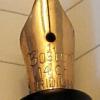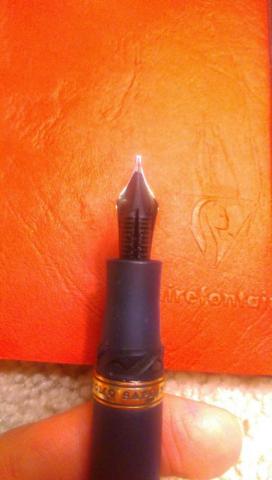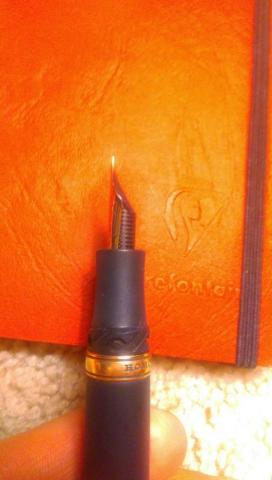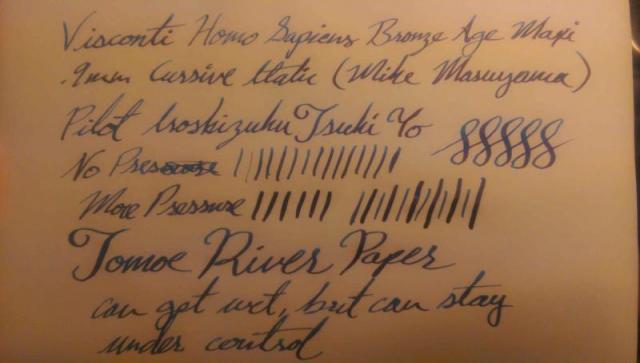Search the Community
Showing results for tags 'wetness'.
-
To all those who own (tried) both pens, i would like to ask why are western nibs (pelikans specifically) are know to be wetter than the Japanese nibs (considering same nib width on paper and not marking) . Is it because of the feed/nib material or the engineering of the feed/nib ?
-
So, I sent a few pens nibmeister for tuning. And I mentioned to make them wet pens (8/10) 'cause I wanted them to be slightly wetter than John Mottishaw's (7/10). After receiving I found that the pens are really wet. Couple are so wet that the feed(even underside) is always saturated and they write as if I just dipped the pens in ink. I am thinking of tweaking it myself but I cannot find any info online except to make the pen drier by closing the tines. The tines are already pretty closed. So looking for some advice on making the feed a bit drier for Visconti Palladium, Sailor and Jowo nibs.
-
I am considering getting a Pelikan M1000. I was looking for advice on the FB FPN and there were comments about how wet the pen and how it was not meant to do much line variation. So........ How wet is it? If too wet can that be fixed with different ink or other. How much line variation can you safely get?
- 10 replies
-

Black Ink Of Wetness In Between Waterman Black And Aurora Black
3nding posted a topic in Inky Thoughts
Hi everyone! I have a pen that writes too wet with Aurora Black and too dry with Waterman Black, so I am looking for an ink whose wetness is somewhere in between, although a bit closer to Aurora Black in terms of wetness. Also, if it is a really dark black that's a plus! Thank you all very much in advance! -

Pens That Change From Bone Dry To Very Wet
TheDutchGuy posted a topic in Fountain & Dip Pens - First Stop
In this discussion, I noted that a lot of my newly bought pens started out bone dry but became wet (or even very very wet) later on. Initial flushing and cleaning to clear out oils and residues didn't help. Using very wet inks didn't help, or only a little bit. I think this phenomenon may be relevant because quite a few people complain of certain pens being (too) dry. Kaweco is a brand that is often mentioned in this context and sure enough my two Kawecos were initially very dry. So was my Visconti van Gogh, that one was unusable. Over time, these pens very gradually became wet and the Visconti became very wet. I'm now sort of moving towards dryer inks with these pens! The conclusion is that (for example) Kaweco pens are not dry pens, but that many of them start their life as a dry pen. Why? Many people start tinkering with nibs to make new pens wetter. Is this needed? I think (emphasis on: think) the answer lies in materials science. The nib is new and has not been exposed to ink yet. The feed is new. The converter is new. Flushing and cleaning may help a bit, but it didn't help me much with these pens. There's a lot of surface area in a feed. My hypothesis is, that over time, with use, the surface tension characteristics of the converter, the feed and the nib change. This then gradually leads to a wetter pen. This hypothesis is supported somewhat by my observation in multiple pens that a small drop of glycerine speeds up this process; immediately the pen becomes wetter, and after one or two fills with glycerine-enriched ink the pen it stays wetter (search FPN for glycerine; much has been said about it; it's completely different stuff than photoflow). My personal view is, that wetness can only be objectively determined in a well-used pen. Saying that a new pen is dry is like saying that a freshly picked green banana is hard. The banana takes time to ripen. A pen takes a lot of use to show its true character. It might be different with top-quality pens like an M1000 or a 149 or something similar. I didn't notice it with my new Sailor pens, for example. But with entry-level or intermediate-level pens, I've noticed this too many times for it to be a coincidence. In reverse, a new pen that is very very wet might become too wet later on. Something to watch out for. My approach now is: if I like a new pen in every aspect except dryness, I thoroughly flush it, clean it and then add a little bit of glycerine to the first two fills. Then I do a fill without glycerine. This seems to do the trick. Anyway, just my 2 cts. (Obviously we might criticize the manufacturer for such temporary dryness, but there's probably not much point in doing so.)- 11 replies
-
- wetness
- capillary force
-
(and 1 more)
Tagged with:
-
hi all: I have used Iroshizuku inks and Waterman inks in my ST Dupont Palladium pen. I love that pen, very high quality, smooth writing. It seems that the Iroshizuku inks - which I love using!!! - are much wetter than the Waterman inks; for that matter, I might try Montblanc inks. I suspect (I don't own a Japanese pen, Pilot, Sailor or other) that Japanese inks might be better suited for Japanese fountain pens than for European fountain pens... given the fineness of the Japanese nibs. Is this a false assumption? Anybody out there have another opinion? Thanks in advance for sharing your thoughts. François
-
I just thought I'd share my experience the other day adjusting the nib of a pen that was writing a bit dry. I was finding that at first, the nib would write well with plenty of shading. But after having written a little without stopping, it would become dryer to a point where the ink was a little pale and there was almost no shading. I tried following the pen manufacturer's (TWSBI) example video on making the nib a bit wetter, but it didn't work. I'm new to this, but I decided to inspect the nib myself using a loupe and do what I thought might help the situation. I found that there was a gap between the nib and the feed, and that I could see through the breather hole to the other side of the nib (even though the pen was fully assembled). Basically, the nib was lifted up from the feed. I'm not sure whether this matters much for capillary action, as long as there is *some* contact between nib and feed, but I decided to bend the nib a little to match the profile of the feed. After having done this, there is better (albeit not perfect) contact between the nib and the feed. In addition, the slit in the nib was misaligned with the slit in the feed, so I fixed this as well. I find now that the pen writes with noticeably more wetness and consistency, although it is not perfect.
-
This one has often been puzzled by those who seek to increase the wetness of a given nib. If a nib lays down a consistent and even line, what then is the purpose behind this desire for more flow? More understandable is the reduction of an overly wet nib to one that is usable. One initial thought was to make the nib to page interface smoother, but beyond there is only so much ink that can fit between these two surfaces. It’s all a bit of a mystery, so could someone please explain the reasoning behind personal flow preferences please?
-
I have always thought the Visconti Homo Sapiens was one of the most beautiful pens ever, not to mention the lava material being so unique. I’ve always wanted one and finally got it. However, I knew I could have a problem with inconsistent ink flow and wetness, because so many others had. I ordered the pen and it was shipped to Mike Masuyama to grind a .9mm Cursive Italic from the broad. Mike does wonderful work, but when I got the pen it was so wet I couldn’t use it on anything but super ink proof papers. Plus, the ink had no character, it was just super dark lines the crinkled the pages. You could actually see the surface tension of the ink bowing up off of the page. Every now and then it would just start dripping ink. I sent it back to him and he tried his best to dry it out. He said the issue was the spacing between the feed and the nib, which sounded right. For a few months I barely used the pen. This was awful because the pen is so nice, doesn’t have to be babied, and fits my hand so well. Last night I took the nib and feed out and was amazed by how poorly the nib and feed fit together. You couldn’t even hold the feed centered on the nib. It was like they weren’t made for each other. So, I took the feed out of my Noodler’s Konrad and cut a slit in it, to match the slit in the barrel of my Visconti. Then I inserted the nib and ebonite feed into the pen. The feed pushed the tines of the nib apart a little bit. So, I boiled some water and dipped the nib and feed in for 30 seconds. I pulled the pen out and used a towel to squeeze the nib and feed and held it there until it cooled off. The tines were no longer pushed apart. I had successfully heat set an ebonite feed into my Visconti Homo Sapiens Bronze Age Maxi! I have been using the pen for the last 24 hours regularly and it is awesome. The flow is perfect. I get shading, decent dry time, and super consistent flow. Another side benefit is I am able to control how soft the nib feels. I like soft nibs, but with my rather sharp italic, I always felt that the nib was a little too soft for anything but the best paper. I set the feed pretty close to the tip of the nib and it has added a little more support and stiffened it up a bit. For anyone disappointed with the extreme wetness and inconsistency of their Visconti Homo Sapiens, you may want to consider installing an ebonite feed which, in my opinion, should have always been there. Ebonite does not repel ink and cause it to bead up like plastic does, lending to consistent flow. If anyone has any questions or anything let me know. I am not a nibmeister or a professional, however I can grind my own nibs, but for special pens I still defer to the masters. In other words, I think that this is something most people can do. The hardest part is cutting out the slit so the ebonite feed fits, but a dremel really helps with that. If you mess it up, you haven’t hurt your pen. Also, I have not altered the original plastic feed, nib, or barrel of the pen, so I can return it to stock form if I need to. Thanks for reading!
- 26 replies
-
- visconti homo sapiens
- ebonite feed
-
(and 1 more)
Tagged with:
-

Anyone Ever Get A Pen Tuned To A 9 Or 10? Or Had A Pen That Wrote That Wet?
lightless posted a topic in Fountain & Dip Pens - First Stop
I've heard of some pens being described as too wet, which gets me to wondering: has anyone ever gotten a nib tuned to a 9/10 or 10/10 on a wetness scale, or have had (or still have) pens that wet? Do any of you have a taste for pens with that kind of flow? Do they write wider, super saturated lines with little to no shading?








